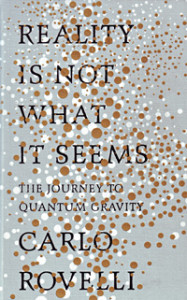Reality is Not What It Seems
by Carlo Rovelli
Published by Allen Lane www.greenpenguin.co.uk
For decades String Theory has been the tail wagging the physics dog when trying to reconcile the estranged but hugely successful theories of Einstein’s curvy spacetime and the pointillist quantum realm. There remains a teeny little problemette though – it hasn’t produced a single result in 30 years. But it’s not the only puppy in the window and in ‘Reality is Not What it Seems’ physicist Carlo Rovelli would like us to consider the outcast runt of the litter – Loop Quantum Gravity.
So what is Loop Quantum Gravity? In this case, about half the book. The first half being a quick history of physics for the last couple of thousand years. Starting with Anaximander in the ancient Greek city of Miletus – the Ionian League version of MIT by Rovelli’s account – we get a pocket history of 2000 years of physics. This could have been a dull little exercise re-treading old ground but Rovelli keeps it bright and breezy. From Democritus’ theory of atoms through the tragedy of Matvei Bronstejn and the autistic genius of Paul Dirac, Rovelli uses brief vignettes to explore how our understanding of reality morphed and simplified across the centuries.
Loop Quantum Gravity (what say we just call it LQG from now on eh?) doesn’t rely on new discoveries but rather reframes what we already know. It’s an approach that worked for Copernicus, Newton, Galileo and Einstein says Rovelli. While each of these – originally bizarre – theories have earned their stripes with confirmation via observation and experiment, LQG isn’t there yet. It hasn’t made any predictions or passed any observational tests. In Rovelli’s words it has yet to “pass it’s exams” (in fairness, String Theory has been blowing off it’s own exams for decades).
Having laid the groundwork Rovelli finally gets down to the nitty-gritty. And a very gritty nitty it turns out to be . What Rovelli and the other LQG researchers are trying to do is quantasise spacetime. Essentially, break Einstein’s smooth curves into jaggy quantum steps. There are two main legs to the argument. First is spacial atoms. Not particles in space, but Planck volume particles OF space. There’s quite a bit more about the intersections of forces and fields but that’s the very basic idea.
The second leg is that we have to dispense with time. All we ever actually measure is motion, says Rovelli, – of pendulums, springs, vibrating atoms – never time itself. This is not a particularly original thought. Newton wrote about it 300 years ago as did Roman philosopher Lucretius 1800 years before that. Schoolchildren regularly re-discover the idea. My own personal epiphany “there is no time, only motion” is scribbled in blue biro inside the cover of my school Log Table book. Rovelli however, wants us to take the idea at face value – to abandon the no longer useful illusion of time as a separate entity and speak only of the interactions of matter. This is a simple yet intriguing idea which will be probably be of no use whatsoever as an excuse when your boss asks why you’ve been late three times this week (unless he’s a physicist researching LQG in which case – give it a shot). Despite the complex issues Rovelli mostly stays away from equations but like an overexcited translator he does lapse into his natural language of mathematics when he can’t quite find the right words. Thankfully such occasions are rare and usually confined to the footnotes
With String Theory looking more and more like a dead end, Loop Quantum Gravity may turn out to be the next big thing. If so, ‘Reality…’ is a handy guidebook to the even stranger realms of physics we may be obliged to navigate.
